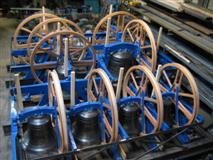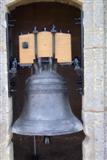APPENDIX - Postscript and update
This account is largely drawn from the website material produced by Mark Walker and Martin Crick and from published accounts in the Ringing World for 2005-6.
1. The complete restoration of the bells has been an aspiration of the Abingdon ringers for several generations. It has now been completed at a total cost of over £160,000. A large part of this sum came from a single bequest, supplemented by the donations of other contributors to the fund. The new bells were dedicated and blessed by the Bishop of Reading, the Rt.Revd. Stephen Cottrell, on Tuesday 25 July 2006.
2. The principal benefactor was Edgar Humfrey (1870-1956), a former Abingdon ringing master who left a large bequest specifically for the bell fund. This whose generous legacy is commemorated in the inscription of the new tenor bell, cast some fifty years after his death. Edgar Humfrey's life and ringing career spanned a significant time in the history of Abingdon bells, and the following brief account from his obituary in the Ringing World of 28 December 1956 p.828 may be of interest:
MR. EDGAR HUMFREY
Ringers in Reading were sorry to hear of the death of Edgar Humfrey in his 87th year.
He first commenced ringing at Abingdon in 1887, where he was foreman for two periods of four years. His first peal was in 1887, conducted by Rev. F. E. Robinson. In all he rang 43 peals with F. E. R.
Mr. Humfrey first conducted a peal in 1888, calling Holt's Ten-part, and in 1925 he called Holt's Original at Caversham. He rang his first peal of Surprise at the age of 78, and rang in a peal of Stedman Cinques at Reading on his 80th birthday.
In one of his diaries Mr. Humfrey records that in 1886 he rode a pennyfarthing from Abingdon to Crystal Palace, to Brighton and back to Abingdon, in four days - a distance of 230 miles. In more recent years he used to cycle from Reading to Abingdon at the time of the Oxford Festivals.
Mr. Humfrey served in the Yeomanry in the Boer War and was a volunteer in the 1914-18 war. He was on the staff of the National Pig Breeders' Association, from which he retired 20 years ago. Whilst a ringer at St.Laurence's, Reading, he was for many years churchwarden St Woodley Church and also its treasurer for 19 years.
He was very active for his age, and only two days before his death he had lopped all the trees in Woodley churchyard.
[List of his 171 peals]
3. After some five years in planning the project and negotiating the necessary permissions, work finally got under way in 2005 when orders were placed for the new bells, installation and associated building works and repairs to the clock. The old bells remained in the tower as long as possible so that they could remain in use. They were rung for the last time on New Year's Day 2006.
4. Work started in January 2006 to prepare the bells for removal from St Helen's prior to their replacement by a new ring. The bellhangers arrived in mid-February to remove the bells and the bell frame, helped by seven Abingdon bell ringers as volunteer labourers who had already dismantled the wheels, clappers and ropes and cleared the ringing room. The clock was also removed for restoration at this stage.
5. The new bells were cast in batches at the end of 2005 during October, November and December at the Whitechapel Bell Foundry. Cast to Gillett & Johnston profiles and tuned on the true-harmonic system, the new bells are modelled on the Gillett ring of 1934 at Ranmoor, Sheffield. The new ring is in the key of F, and a little lighter than the previously bells - with a tenor of 16 cwt (instead of a ton) - to reduce the strain on the tower and allow them to fit all on one level.

6. After tuning the ten new bells were delivered to the bellhangers, Whites of Appleton, in early February 2006. Following the completion of the new cast iron frame and new ringing fittings the installation was assembled at the works (see picture). The Abingdon bells and their frame were on show for public viewing at an Open Day at Appleton on 20 May 2006. The bells were then dismantled ready for installation in the tower.
7. The ten bells have been hung in a new cast iron frame on one level. The frame is of lowside type (similar to Bellframes type 8.3.A.h) as shown in the bellhanger's drawings (NB with north - not east as with most other drawings in this report - at the top). The bells are fitted with modern ringing fittings including cast iron stocks, ball bearings, wheels, stays and sliders, clappers with independent staples etc. New homes have been found for most of the old bells. The six smallest - currently (July 2006) in store at Loughborough - are due to be installed at St Cyrians Cathedral, Kimberley, in South Africa. The old seventh is being rehung as a clock bell at the Church of King Charles the Martyr at Falmouth in Cornwall. The old eighth (1764) will be used to replace a later bell in the otherwise near contemporary ring of 1768 at Long Crendon in Buckinghamshire. The two heaviest bells of 1885 have been sold to the Whitechapel Bell Foundry at scrap value.
9. The four large medieval foundation beams and two of the lower sills of the frame have been preserved in situ just below the new frame. In addition, one side portion of the old frame has been preserved and is displayed in the clock room. Beyond that, this report and the accompanying drawings serve as a record of the old frame.
10. Details of the new bells are as follows:
Bell Founder and date Diameter
(inches)Note Weight
(cwt.qr.lb.)1, Whitechapel, 2005 2413/16 A 4-1-6 2, Whitechapel, 2005 257/8 G 4-2-4 3, Whitechapel, 2005 271/8 F 4-1-20 4, Whitechapel, 2005 283/16 E 5-0-20 5, Whitechapel, 2005 291/4 D 4-3-18 6, Whitechapel, 2005 31 C 5-3-26 7, Whitechapel, 2005 331/4 B flat 7-0-20 8, Whitechapel, 2005 357/16 A 8-0-24 9, Whitechapel, 2005 3815/16 G 10-3-20 10, Whitechapel, 2005 44 F 16-0-0
11. The wording of the bell inscriptions - recording the names of donors and those in whose memory the new bells have been given - are as follows:
Bell Inscription 1. FOR THE PRAISE OF GOD, A & R & S 2005 2. ABINGDON BOROUGH CHARTER ANNIVERSARY 1556-2006, ABINGDON TOWN COUNCIL, ABINGDON JOINT ENVIRONMENTAL TRUST 3. THE GIFT OF SUSAN AND BRIAN READ 4. THE GIFT OF TIMOTHY PETT IN MEMORY OF HIS PARENTS, LEONARD AND MARGARET 5. RODERICK BRENDA JOHN & DAVID HUNT, ORDO AB CHAO 6. M PATRICIA DIXON, SING UNTO THE LORD 7. JOHN H S DIXON, REJOICE IN THE LORD 8. ALAN WINTER, 6/12/1920 - 11/9/1986; MAGGIE WINTER 18/11/1919 - 9/6/2004; CLIVE BEAUMONT 15/10/1947 - 29/4/1999. THE GIFT OF HELEN BEAUMONT AND ALAN T WINTER 9. LEWIS & JOAN RATTENBURY, MARRIED 7 JUNE 1941 - 31 MAY 2003. MAKE A JOYFUL NOISE UNTO THE LORD … PSALM 100 10. LAUS DEO / (ornamental border)
Waist: EDGAR HUMFREY: 1870 - 1956 / BY WHOSE BENEFACTION / THIS RING OF BELLS WAS INSTALLED IN / THE CHURCH OF ST HELEN / PRAISE HIM UPON THE LOUD CYMBALS.
Opposite: MICHAEL GOODE - RECTOR. / MALCOLM HARVEY } / SUSAN SCOTT } CHURCH WARDENS. / THE ABINGDON SOCIETY OF BELLRINGERS / 10 / 20 (Whitechapel mark) 05 / WHITECHAPEL (ornamental border)
12. The Tenor is a highly decorated bell with an inscription commemorating Edgar Humfrey, the principal benefactor. In addition each bell bears an ornamental border immediately below the lower moulding wires of the (blank) inscription under the shoulder, and the words a) WHITES OF APPLETON / CHURCH BELLHANGERS and b) 20 (Whitechapel mark) 05 / WHITECHAPEL

13. In addition, the associated building work has included repairs to the belfry windows and installation of an improved sound control system, a new door to the bell chamber, improvements to the access arrangements to the clock room and above the bells (ladders and platform) etc.
14. The work has also involved repairs to the Sanctus bell which has been rehung with new fittings. These include a new wooden stock with plate gudgeons, ball bearings fixed to steel plates bolted to the walls of the aperture in the base of the spire, iron chiming lever and clapper with independent staple. The bell has also been cleaned and quarter turned.
15. Lastly, the scheme has included the restoration of the 1845 clock movement, the fittings of automatic winding gear and the removal of the old casing and chutes associated with the clock weights etc.
CJP
28 July 2006
© Copyright 2006, Chris Pickford, Mark Walker and Martin Crick
 ABINGDON BELLS: Appendix
ABINGDON BELLS: Appendix